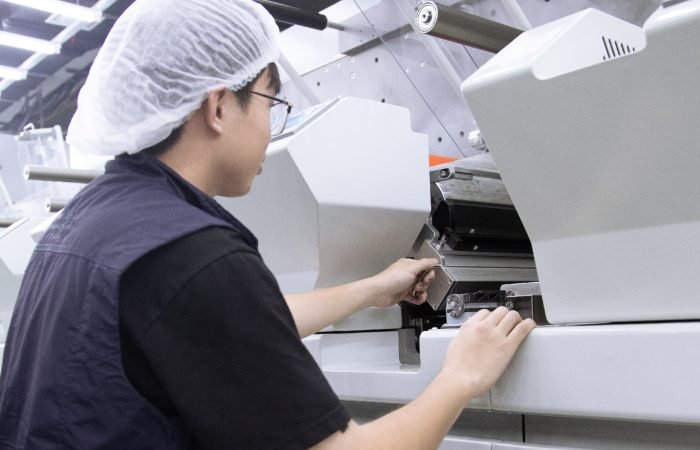The demand for crisp, vibrant white ink in printing has skyrocketed across packaging, labels, and specialty applications. Achieving that perfect opaque base layer requires more than premium pigments – it demands curing technology that keeps pace with modern production needs. Enter UV LED systems, revolutionizing how printers handle high-density whites across flexographic, offset, and narrow-web platforms.
White ink challenges traditional curing methods. The titanium dioxide particles that create opacity scatter light differently than colored pigments, requiring precise energy delivery. Older mercury-arc lamps struggle with inconsistent curing through thick white layers, leading to tacky surfaces or incomplete polymerization. This becomes critical in label printing where subsequent layers must adhere perfectly to white underbases.
UV LED’s narrow wavelength output (typically 365-395nm) targets photoinitiators in white inks more efficiently. Unlike broad-spectrum mercury lamps wasting energy on irrelevant wavelengths, LED systems deliver focused energy where it matters. Printers report 30-40% faster curing speeds for white layers using LED, particularly noticeable in narrow-web presses running metallic substrates that demand flawless white backgrounds.
The instant on/off capability of LED arrays proves invaluable for sheetfed offset work. White ink sections can be cured immediately after application without heat buildup warping delicate stocks. A commercial printer handling cosmetic packaging shared how switching to LED reduced substrate distortion by 62% compared to conventional UV systems – crucial when printing on temperature-sensitive synthetic papers.
Flexographic operations benefit from LED’s ability to maintain consistent irradiance across web widths. A case study from a European label converter showed 0.02% variation in cure strength edge-to-edge versus 15% with older systems. This uniformity prevents weak spots in white underlayers that could compromise overprinted colors in complex label designs.
Energy consumption metrics reveal another advantage. Mercury lamps operate at 200-600 watts per inch, while comparable LED systems use 50-150 watts. For 24/7 narrow-web operations, this translates to annual energy savings exceeding $20,000 per press. The lack of ozone generation eliminates expensive ventilation upgrades – a key factor for urban print shops expanding white ink capabilities.
Material compatibility expands with LED curing. Heat-sensitive films like BOPP and PE retain dimensional stability during white ink processing. A flexible packaging converter reported 80% reduction in film shrinkage during white layer curing, enabling tighter registration for subsequent print stations. The cooler operation also allows use of thinner gauge materials without distortion – critical for lightweighting initiatives in food packaging.
Ink manufacturers have responded with LED-optimized white formulations. These contain photoinitiators tuned to specific LED wavelengths, achieving full cure through layers up to 12μm thick. Testing shows 95% polymerization within 0.3 seconds at 300 mJ/cm² exposure – performance unattainable with mercury-based systems. The latest hybrid inks maintain opacity while reducing titanium dioxide content by 18%, addressing cost concerns without sacrificing brightness.
Pressroom workflows transform with LED integration. One North American label printer eliminated separate curing tunnels between print units by implementing inline LED arrays. This reduced their white ink production floor space by 40% while increasing throughput to 230 feet/minute. The immediate cure after each white layer application prevents ink contamination in subsequent stations – a persistent issue in multi-pass metallic label production.
Maintenance comparisons highlight operational advantages. Mercury systems require lamp changes every 1,000-1,500 hours with gradual intensity decay. LED arrays maintain peak output for 15,000-20,000 hours with no performance drop-off. For a mid-sized label converter, this reduces annual maintenance hours from 300 to under 40 while eliminating mercury disposal costs and regulatory paperwork.
The environmental profile seals LED’s advantage. Mercury-free systems align with sustainability goals while meeting stringent VOC regulations. A beverage company audit showed 90% reduction in hazardous waste from their label printing process after adopting LED-cured white inks. Print buyers increasingly specify LED-cured packaging to meet corporate sustainability targets – a market differentiator for converters.
As substrate diversity grows, LED systems adapt through programmable intensity controls. Printers can store curing profiles for different material/ink combinations – matte films might require 15% higher intensity than glossy stocks for equivalent white layer curing. This digital control prevents over-curing delicate materials while ensuring adequate polymerization across varied jobs.
The future points to smarter integration. Emerging systems link LED arrays with spectrophotometers for real-time cure verification. If a white layer measures below target opacity, the system automatically adjusts UV output on subsequent copies. This closed-loop control will prove vital as brand owners demand ≤1% color variation across global packaging runs.
For printers hesitating at the capital cost, the ROI timeline has compressed. Updated payback models factor not just energy savings, but reduced waste from curing defects, faster job turnover, and premium pricing for LED-certified prints. Most mid-volume operations recoup costs within 18 months – faster for shops running multiple shifts.
The shift isn’t just technical – it’s perceptual. Brands now associate LED-cured whites with premium quality. That bright, consistent base layer becomes a visual shorthand for product excellence. As one packaging designer noted, “The whites make our metallics pop in ways we couldn’t achieve before. It’s become a signature element in shelf impact.”
From label presses to folding carton lines, UV LED technology redefines what’s possible with white ink. The combination of precision curing, material flexibility, and operational efficiency creates opportunities for printers to elevate quality while controlling costs. As substrate and ink innovations continue, this synergy between formulation and curing technology will drive new applications in decorative printing, security features, and functional coatings.
Those who’ve adopted the technology report unexpected benefits – easier compliance with food safety standards due to complete ink polymerization, reduced static in finishing operations from drier substrates, even extended anilox life from better ink release. It’s becoming clear that LED curing isn’t just an alternative to mercury systems, but a foundational technology for next-generation printing.
The message from early adopters is consistent: high-opacity white ink jobs that were once problematic now run smoothly. Rejects from curing issues have plummeted, while color consistency meets brand specs that previously seemed unattainable. For printers looking to future-proof their capabilities while addressing today’s cost pressures, UV LED systems offer a compelling path forward.












